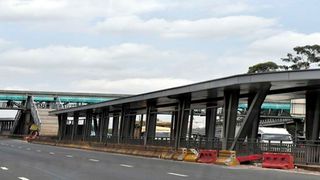
A BRT station under construction. A comprehensive public transport system for millions of Nairobi commuters remains a distant dream as construction has stalled for months along the Thika Superhighway.
| File | Nation Media GroupNews
Premium
Nairobi BRT system remains a distant dream
A comprehensive public transport system for millions of Nairobi commuters remains a distant dream as construction has stalled for months along the Thika Superhighway.
The Bus Rapid Transit (BRT) project was supposed to offer a reliable, secure and comfortable system for city residents. It had sought to revamp Nairobi’s chaotic public transport infrastructure to reduce congestion, but it remains a pipe dream given the snail-pace’s progress of the project.
How did BRT, an affordable and flexible alternative to fixed-rail transit, stall in one of Africa’s most congested cities? An efficient BRT system includes enclosed stations, centralised management of buses and adequate access facilities.
For almost a decade, the Nairobi Metropolitan Area Transport Authority (Namata) has been promising city commuters the BRT system. It was to be launched on February 1, but we are now in March.
Like other services, Namata Director-General Francis Gitau blamed the delay on the Covid-19 pandemic. Speaking to journalists at Ardhi House on February 10, he said the BRT was 70 per cent done.
Work still going on
He was accompanied by the Principal Secretary in the State Department of Housing and Urban Development, Mr Charles Hinga.
“We are working at the factory on the structures, which once completed, will be delivered on site. Work is still going on and we are expecting to start trials by July,” said the PS.
“It should be a source of pride for Nairobi. I hope I won’t have to drive to work and instead will be able to park at a BRT facility and then take the bus to town,” he added.
Mr Hinga denied that work had stalled, saying: “The bulk of it happens in a factory because it’s a fabrication of steel; we don’t do it by the road.”
Mr Gitau had said that the BRT Nairobi depot in Kasarani would be ready by February, but no construction is going on. The corrugated iron sheets have been vandalised.
The Motorist Association of Kenya chairman Peter Murima faulted the design of the highway.
“The BRT system expected to transform mass transportation in the city will turn out to be a big, costly mistake,” he said.
The Thika Superhighway is notorious for traffic snarl-ups during the rush hour. One of the worst sections is between Pangani and Junction 6 at the Survey of Kenya, a distance of just 2.5km.
Intelligent traffic systems
Mr Hinga said BRT will use intelligent traffic systems where there are no dedicated BRT corridors.
“In the Pangani interchange, where we have six lanes narrowing to a few, we shall implement the ITS system that allows us to install the Urban Traffic Control. This is the process of controlling traffic signals remotely. It will allow the buses to communicate with the ITS,” the PS said.
“In case of any delays, the BRT will communicate to the ITS, alerting them to keep the lights on for some minutes as they try to catch up,” he added.
The Advanced Public Transport Management System will notify commuters of the schedule. “The system will let commuters know when the bus will arrive or how far it is and where its next stop will be,” he said.
Construction of the BRT means at least one lane is shut down to traffic at different sections during the day or night. When it’s done, one inner lane on either side will be sealed off to private motorists.
While this will make it easier for those using public transport, MAK said it would create congestion. “Congestion will be worse once the right lane is reserved for BRT as the other two won’t be enough for 150,000 vehicles, which ply on each side of the highway,” said Mr Murima.
Transport Cabinet Secretary James Macharia told Parliament in 2019 that the government would spend Sh5.8 billion to build a lane for high-capacity buses on Thika Superhighway.
“The design infrastructure is going on under the Kenya National Highways Authority, which has estimated the cost to be Sh5.8 billion,” Mr Macharia told the National Assembly’s Transport Committee.
Park-and-ride
A park-and-ride facility is being set up at Kasarani, where motorists heading to the city centre can leave their vehicles and use BRT buses for the remainder of the journey.
In 2020, Stecol Corporation, previously known as SinoHydro Tianjin Engineering Company Ltd, signed a memorandum of understanding to build the BRT system.
The project starts at the Kenyatta National Hospital terminal to the Ruiru Station, about 27km long. The dedicated BRT line is about 20.18km.
Mr Gitau had earlier said that there will be 13 intermediate stations, but last week he noted that they will be 10 with 24 platforms (two-line transfer stations reserved for future lines).
Work on the designated BRT stations has stalled at Garden City, Safari Park, Roysambu, Clayworks, Kahawa Barracks and Kenyatta University, with no activity going on there for months.
The red barriers that had dotted the highway were removed after they became a hazard to motorists.





